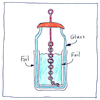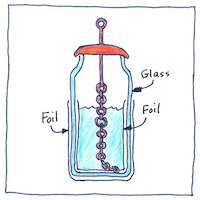Ewald Georg von Kleist, Pieter van Musschenbroek
electromagnetism

|
Leyden jar
Von Kleist and van Musschenbroek had the same teacher in Leyden, Willem’s Gravesande, and invented the same device, the Leyden jar. They thought electricity was a fluid, so why not fill a jar with water and place in it a brass rod to capture an electric charge? The glass of the jar became a dielectric, separating the water inside from a metal foil wrapped around the jar or, originally, from the hand holding the jar. The Leyden jar preceded the electric battery and enabled storage of electricity for serious study by Daniel Gralath, Alessandro Volta, Benjamin Franklin, and others. Volta used a Leyden jar to fire a pistol at fifty kilometers. Franklin used one to store an electric charge from rainclouds. Martinus van Marum used Leyden jars for electrolysis of metal salts. Marconi used one in his spark-gap transmitter.
Capacitance
The Leyden jar was the first capacitor. and the original unit for capacitance was the jar. The modern unit is the farad in honor of Michael Faraday. One coulomb of charge on each side of the capacitor causing a voltage across the device of one volt is a capacitance of one farad. One jar is a little over one billionth of a farad. Modern supercapacitors have capacities up to ten thousand farads.
Shock
Von Kleist and van Musschenbroek’s assistant were both shocked to discover how much electricity their Leyden jars discharged.



Von Kleist and van Musschenbroek were wrong to think that electricity was a fluid, and Franklin was wrong that the electricity was contained in the glass of a Leyden jar. Useful discoveries are not always based on correct theories.
See also in The book of science:
Readings in wikipedia: